| |
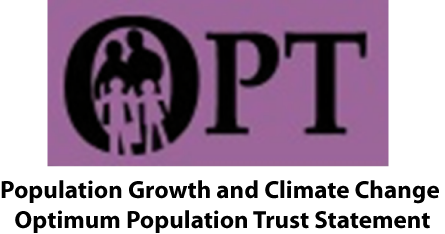

OPT recommends: "That the principle of contraction & convergence (rich & poor converging towards a common per person emissions target) be accepted as an equitable starting point for distributing total tolerable carbon emissions, provided that this is allocated to states on the basis of their population size at a specific date. This would encourage the adoption of population restraint policies; whereas allocation on a simple per person criterion would encourage continued population growth, thus continuously reducing every person’s carbon entitlement."
Statement endorsed by: -
Sir David Attenborough,
Naturalist, Broadcaster and wildlife film-maker*
Prof Sir Partha Dasgupta,
Frank Ramsey professor of economics, University of Cambridge*
Prof Paul Ehrlich,
Professor of population studies, Stanford University*
Prof John Guillebaud,
Emeritus Prof family planning, University College, London*
Susan Hampshire,
Actor and population campaigner*
James Lovelock,
Gaia scientist and author
Professor Aubrey Manning,
Pres Wildlife Trust, Emeritus Prof Natural History, Edinburgh University
Professor Norman Myers,
Visiting Fellow, Green College, Oxford University*
Sara Parkin,
Founder/Dir and trustee, Forum for the Future*
Jonathon Porritt,
Founder/Dir, Forum for the Future; Fmr Chair, UK Sus. Dev. Commission*
Professor Chris Rapley,
Former director, the British Antarctic Survey
The Optimum Population Trust on C&C
"Contraction and Convergence is a prime example of a UNFCCC-compliant Global Climate Change Framework. It is a rational formulation for reconciliation of 'Climate Justice without Vengeance'. Several ideas derived from C&C have surfaced since Kyoto with ideas that can be perhaps in various ways incorporated into C&C. However, there is an overwhelming need for an over-arching UNFCCC-compliant Framework that enables the globally competing interests of the over-consuming and the under-consuming to be reconciled with each other and with the objective of the UNFCCC in a non-random manner. We feel that C&C is the veteran and indeed the apex example of this and urge you to consider our request. At Kyoto in December 1997 and shortly before they withdrew from these negotiations, the USA stated, “C&C contains elements for the next agreement that we may ultimately all seek to engage in.” The adversarial reasons for their withdrawal then were in play again at COP-15. C&C answers this in a unifying and constitutional way and the need for this answer becomes increasingly critical."
Letter & signatories at: -
Steven Earl Salmony
AWAREness Campaign on The Human Population [estab. 2001]
Jonathon Porritt
Forum for the Future
Sara Parkin,
Founder Director, Forum for the Future
Roger Martin
Chair, Optimum Population Trust
For fuller support list go here

Contraction and Convergence
Climate change is driven, and its impacts are experienced, to different extents by different populations
across the globe. Total emission figures mask a huge heterogeneity in per person energy consumption
which varies widely both within national borders and between them. Equity, including equality of
opportunities for development, must therefore be the central pillar around which climate change policy
is developed. In response to these discrepancies, ‘Contraction and Convergence’ presents a framework in which
finite bio-spherical capacity is equitably shared amongst all of the earth’s inhabitants, thus placing the
importance of per capita emissions centre stage. This framework recognizes the right of the developing
world to develop economically, and that their per capita emissions will rise as a result. On the other
hand the emissions of the developed world will have to contract, with the overall objective of arriving at
an equitable global per capita emission level. Population growth is fundamentally relevant to this
model, since total population size will largely determine the cap at which total safe emissions can be
set. Again the complexity of this issue is crucial to grasp: in the short term, it will be in the interests of
individual countries to have large populations to capture as large a share of the global emissions as is
possible. At the global level the reverse is the case; the larger the global population, the smaller the per
capita global emission level will be.
PSN will promote increased understanding of the links between population and climate change and advance approaches, such as contraction and convergence, which mirror the PSN ‘Population – Consumption Coin’ concept by recognizing the twin rights and responsibilities of the developed and developing worlds.
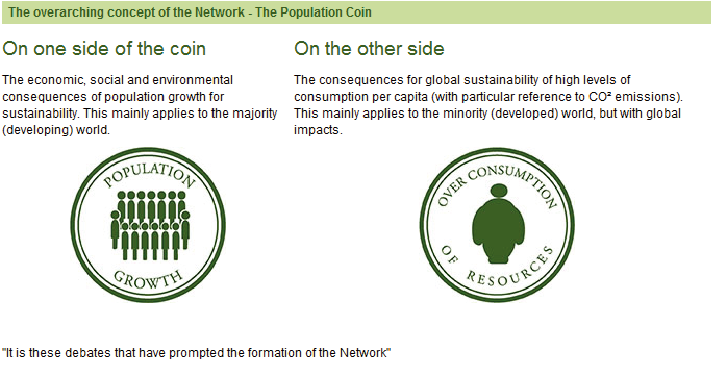
The Population and Sustainability Network
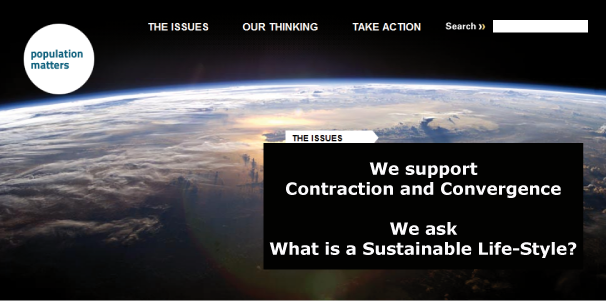
"Humanity as a whole is already consuming more resources than the earth can in the longer term provide. Therefore consumption in the richer countries will have to be reduced to allow those in poorer countries to attain a decent lifestyle. Consumption will inevitably grow in developing countries as they industrialise and urbanise, even if they take on board the need for sustainable lifestyles. It will be up to wealthier communities, principally in developed countries, to moderate their lifestyles and adopt consciously green practices. We already know that what one country considers acceptable would be considered far from acceptable to another. How should the level be set? By whom? On what criteria? The concept of Contraction and Convergence (C&C) was conceived by the Global Commons Institute in the early 1990s. The principle is that the rich should consume progressively far less resources per capita than before, while the poor consume rather more than they did, so we converge towards a common ‘fair share’ for each, which the planet can sustain. We support this principle of C&C or global equity, but it must take account of the plain arithmetic fact that every additional person reduces everyone else’s sustainable share. We have therefore insisted on including a population base year at which the ultimate target figures, notably for sustainable carbon emissions per person, should be calculated country by country. Without it, countries with high population growth would consume ever more, at the expense of those who had succeeded in restraining or reducing their numbers. We were delighted when Kofi Annan endorsed our view in his Chairman’s Key Recommendations following a conversation we had with him after a workshop we gave at the Global Humanitarian Forum in June 2009."
Population Matters

This Policy Position Statement (PPS) sets out CIWEM's position on the importance of addressing current levels of population growth, resource consumption and moving towards living within environmental limits in the UK.
For some pollutants such as carbon dioxide we have a fairly clear scientific understanding of the carrying capacity and the reductions required. The Global Commons Institute proposed the system of "Contraction and Convergence", which provides a mechanism for reducing carbon emissions and tackling climate change in an equitable manner. Its principle could be extended to wider environmental pollution and resource exploitation quota systems. Presently many industrialised countries effectively export much of the pollution associated with their consumption, as manufacturing and raw materials production have moved to less industrialised countries where labour and resources are cheaper and environmental regulations are less stringent. As such countries industrialise and their domestic demand for products increases as a result of wealth creation, such environmental pressures are likely to increase further before they become more tightly regulated.
CIWEM calls for:
- An end, globally, to the presumption that economic growth and population growth are essential for a successful society, with societal wellbeing and a healthy natural environment afforded greater status in this respect.
- A demonstrable commitment by the Government to align all aspects of the UK economy, including its population, with the principle of living within environmental limits.
- An urgent and informed public debate on sustainable human population movement and growth for the UK using independent research and data which also measures the impact of people's lifestyles on the environment, and considers issues such as faith, cultural attitudes, poverty and migration.
- The Government to monitor and report on the impact of population and people's lifestyles on the environment, such information being essential to planning and evolving communities and to planning for action on climate change.
- Wider education, especially in schools, regarding the environmental impacts of the UK's consumer culture, with a focus on more needs-based living, society and family.
- A complete review of all benefits and fiscal policies to identify any perverse incentives for people in the UK to have more than two children, leading to a non-coercive policy which encourages people to 'stop at two'.
- Wider public education regarding reproduction and fertility, in all areas of global society, and provision of free family planning support to all.
- The UK to lead the way in international negotiations to increase levels of overseas development committed to educating men and empowering women to take greater control of their own fertility.
- A clear and concerted effort to eradicate poverty, recognising the clear correlation between poverty and higher reproduction rates. This effort should foster development not based on a traditional western model and utilise leading techniques and technologies which are 'light touch' on the environment.
The Chartered Institution of Water and Environmental Management (CIWEM) is the leading professional body for the people who plan, protect and care for the environment and its resources, providing educational opportunities, independent information to the public and advice to government. Members in 98 countries include scientists, engineers, ecologists and students.
Chartered Insitute for Water and Environmental Management [CIWEM]
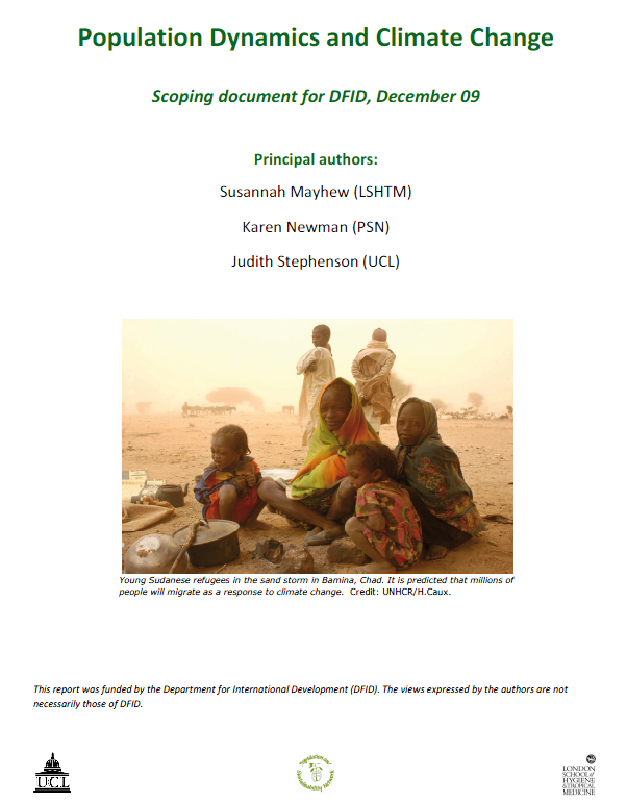
Contraction and Convergence
Climate change is driven, and its impacts are experienced, to different extents by different
populations across the globe. Equity should therefore be a maintained as a guiding principle
around which climate policy is developed. The model of contraction and convergence seeks
to develop a framework in which the finite biospherical capacity is equitably shared amongst
all of the earth’s inhabitants. Contraction and convergence describes a process whereby the
high emitters of green house gases contract the rates at which they consume fossil fuel
energy and eventually converge at a sustainable level with those who need to increase their
consumption above what they currently consume in order to achieve satisfaction of
necessary material and social needs. It has the advantage of explicitly recognizing the
developing world’s right to develop, and the likelihood that their per capita emissions will
grow as a result of this process, and of identifying a globally equitable way of managing this
within the context of a global need to reduce carbon emissions.
There is an important distinction to draw between the “luxury” and “survival” emissions
produced between different populations and the patent and urgent need to address gross
inequalities and widespread poverty experienced in many parts of the world. Addressing
human development through stimulating economic activity and other means of improving
human welfare will inevitably lead to increases in GHG emissions; there is hence an allowance
for an increase in emissions from poor populations in the contraction and convergence
model. The budget at which emissions should contract to is estimated to start at 450 CO2
ppm (at the time that Kyoto was created), which may have to be revised downwards towards
350 ppm, this however doesn’t account for any feedbacks triggered in the climate system
which might mean that the budget would have to be set even more conservatively.
The convergence date sets 2100 as an approximation to reach a globally equitable
distribution of energy consumption, though efforts should be focused on the earliest date
possible, as we move past the point of equity for equity’s sake towards the pursuit of equity
for survival.
Since this model is based on equilibrium between per capita and total rates of emissions,
population is a critical factor influencing its achievability. Population projections are central
for the subject of negotiation, and increasingly so if the medium UN 2050 projections, upon
which the contraction allowance was crafted are jeopardized as a result of a crumbling base
of global family planning services resulting in stalling rates of fertility decline in many
countries. Population is the major denominator of this model, largely determining how hard
it will be to achieve a globally feasible and equitable per capita emission figure; at the global
level, a larger world population means a lower, more difficult to achieve, number. Similarly it
could prove counter-intuitive if it became in the interest of nations to stimulate population
growth in order to increase their share of the global emissions budget in an absolute sense.
Population Dynamics and Climate Change
Study for DFID December 2009
Susannah Mahew, Karen Newman, Judith Stephenson

Contraction and convergence - What is a sustainable lifestyle? Humanity as a whole is already consuming more resources than the earth can in the longer term provide. Therefore consumption in the richer countries will have to be reduced to allow those in poorer countries to attain a decent lifestyle. Consumption will inevitably grow in developing countries as they industrialise and urbanise, even if they take on board the need for sustainable lifestyles. It will be up to wealthier communities, principally in developed countries, to moderate their lifestyles and adopt consciously green practices. We already know that what one country considers acceptable would be considered far from acceptable to another. How should the level be set? By whom? On what criteria?
The concept of Contraction and Convergence (C&C) was conceived by the Global Commons Institute in the early 1990s. The principle is that the rich should consume progressively far less resources per capita than before, while the poor consume rather more than they did, so we converge towards a common ‘fair share’ for each, which the planet can sustain. We support this principle of C&C or global equity, but it must take account of the plain arithmetic fact that every additional person reduces everyone else’s sustainable share. We have therefore insisted on including a population base year at which the ultimate target figures, notably for sustainable carbon emissions per person, should be calculated country by country. Without it, countries with high population growth would consume ever more, at the expense of those who had succeeded in restraining or reducing their numbers.
We were delighted when Kofi Annan endorsed our view in his Chairman’s Key Recommendations following a conversation we had with him after a workshop we gave at the Global Humanitarian Forum in June 2009. Population numbers, lifestyles, and sustainable technologies are a classic trade-off. If we want a sustainable future, we need to address not one or two but all three of these issues in parallel.
Population Matters
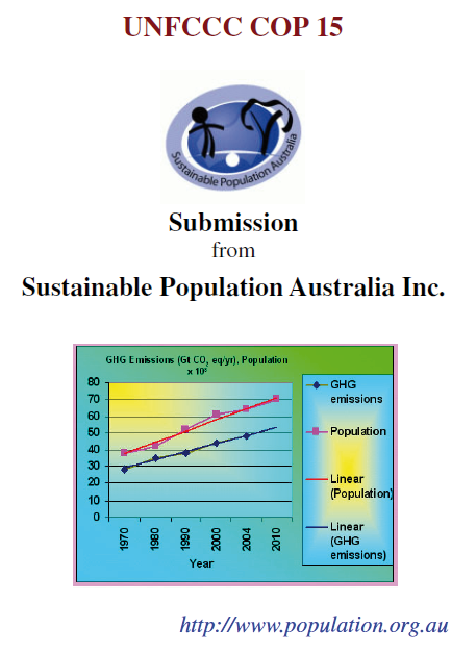
Contraction and Convergence
In the early 1990s, the Global Commons Institute developed the theory of contraction and
convergence as a means to reducing greenhouse emissions in an equitable manner. The Contraction
part lays down an annual fall of global emissions. The Convergence determines how the
entitlements to emit carbon are distributed between the countries of the world and is based on
per capita entitlements. The per capita element, however, risks encouraging countries to increase
their population to earn more entitlements. Thus, if convergence and contraction is to work, it
will be necessary to set maximum populations beyond which no further entitlements would be
gained.
Submission from Sustainable Population Australia for COP-15
|
|








